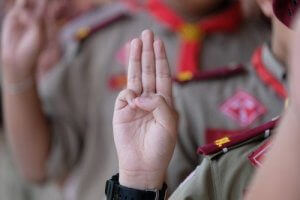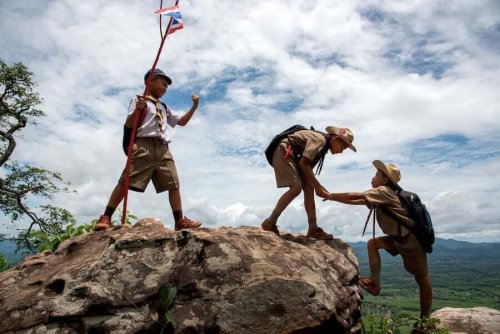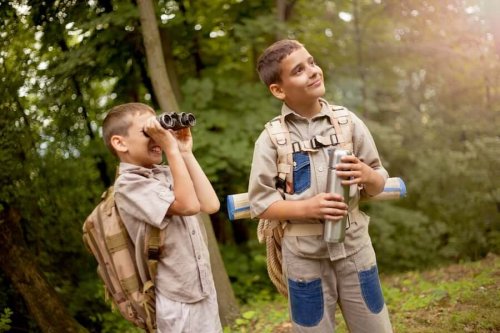What Are Boy Scouts?

Boy Scouts are the main players in a youth movement based on values such as solidarity, mutual aid, and respect. Their purpose is to help young people build their character and personality, while contributing to their physical, mental and spiritual development. Have you heard of them?
The values of Boy Scouts
Teamwork and respect for nature
The movement is based on nature activities and intellectual learning exercises. The Scout Movement encourages young people to gain a deeper appreciation for servicing others. It also promotes activities that lead to improved personal responsibility and self-esteem.
The main goal of the Scout Movement is to help children develop their physical, intellectual, emotional, social and spiritual potential within a team. Its aim is to help young people become independent, responsible, caring, active, engaged and able to make their own decisions, in addition to fulfilling their commitments and reaching their goals.
The pedagogical principle of Boy Scouts is making children and adolescents become responsible and caring adults, who are able to live with their peers and are aware of society’s problems.
The Scout Movement is based on education through play, the spiritual dimension, and respect for the environment. It teaches young people to learn to live with their peers and be responsible.

History of the Boy Scouts
The history of the Boy Scouts dates back to July 25, 1907. That was when Lord Baden-Powell, an official of the British Army, led a diverse group of 21 teenagers to Brownsea Island in Dorset, England, where they camped for 15 days.
With the help of other instructors, Baden-Powell taught the children camping, observing, inferring, crafts, boating, lifesaving, patriotism and chivalry. The children learned many of these lessons through popular creative games.
His idea was that children should be organized into small groups of six or seven under the guidance of a leader, the Chief Scout. Basically, the training consisted of activities such as tracking and recognition, in addition to acquiring first aid skills and all the skills that they’d need to camp and do outdoor activities.
To become explorers, children had to pledge allegiance to their country, help others and generally obey the Scout Law, which in itself is an easily understandable code of conduct for children.
In reality, Baden-Powell had only intended to provide a training method for children but, to his surprise, the children began to organize themselves into what ended up becoming one of the world’s largest voluntary youth movements.
“To learn to live with their peers and be responsible, the Scout Movement is based on education through play, the spiritual dimension, and respect for the environment.”

Benefits and goals of the Boy Scouts
The Boy Scouts Movement, unlike other leisure movements, is very educational. The children work hard through play, teamwork, and respect for nature to learn skills that will help them throughout their lives, in addition to acquiring a leadership role in their community.
The goals of the Scout Movement are aimed essentially at developing individuals to the fullest. They are as follows:
- Training. Learning to live together in the outdoors and learning how camps work, how to observe nature, games, etc.
- Health and physical development. Physical exercises and why they should do each of them, hygiene, games, disease prevention, self-control…
- Self-improvement. Manual skills, job specialization, etc.
- Service to others, the spirit of chivalry and abnegation, mutual aid, first aid, and rescue.
Boy Scouts are the main players in a youth movement based on values such as solidarity, mutual aid, and respect. Their purpose is to help young people build their character and personality, while contributing to their physical, mental and spiritual development. Have you heard of them?
The values of Boy Scouts
Teamwork and respect for nature
The movement is based on nature activities and intellectual learning exercises. The Scout Movement encourages young people to gain a deeper appreciation for servicing others. It also promotes activities that lead to improved personal responsibility and self-esteem.
The main goal of the Scout Movement is to help children develop their physical, intellectual, emotional, social and spiritual potential within a team. Its aim is to help young people become independent, responsible, caring, active, engaged and able to make their own decisions, in addition to fulfilling their commitments and reaching their goals.
The pedagogical principle of Boy Scouts is making children and adolescents become responsible and caring adults, who are able to live with their peers and are aware of society’s problems.
The Scout Movement is based on education through play, the spiritual dimension, and respect for the environment. It teaches young people to learn to live with their peers and be responsible.

History of the Boy Scouts
The history of the Boy Scouts dates back to July 25, 1907. That was when Lord Baden-Powell, an official of the British Army, led a diverse group of 21 teenagers to Brownsea Island in Dorset, England, where they camped for 15 days.
With the help of other instructors, Baden-Powell taught the children camping, observing, inferring, crafts, boating, lifesaving, patriotism and chivalry. The children learned many of these lessons through popular creative games.
His idea was that children should be organized into small groups of six or seven under the guidance of a leader, the Chief Scout. Basically, the training consisted of activities such as tracking and recognition, in addition to acquiring first aid skills and all the skills that they’d need to camp and do outdoor activities.
To become explorers, children had to pledge allegiance to their country, help others and generally obey the Scout Law, which in itself is an easily understandable code of conduct for children.
In reality, Baden-Powell had only intended to provide a training method for children but, to his surprise, the children began to organize themselves into what ended up becoming one of the world’s largest voluntary youth movements.
“To learn to live with their peers and be responsible, the Scout Movement is based on education through play, the spiritual dimension, and respect for the environment.”

Benefits and goals of the Boy Scouts
The Boy Scouts Movement, unlike other leisure movements, is very educational. The children work hard through play, teamwork, and respect for nature to learn skills that will help them throughout their lives, in addition to acquiring a leadership role in their community.
The goals of the Scout Movement are aimed essentially at developing individuals to the fullest. They are as follows:
- Training. Learning to live together in the outdoors and learning how camps work, how to observe nature, games, etc.
- Health and physical development. Physical exercises and why they should do each of them, hygiene, games, disease prevention, self-control…
- Self-improvement. Manual skills, job specialization, etc.
- Service to others, the spirit of chivalry and abnegation, mutual aid, first aid, and rescue.
All cited sources were thoroughly reviewed by our team to ensure their quality, reliability, currency, and validity. The bibliography of this article was considered reliable and of academic or scientific accuracy.
- Denny, K. E. (2011). Gender in context, content, and approach: Comparing gender messages in girl scout and boy scout handbooks. Gender and Society, 25(1), 27–47. https://doi.org/10.1177/0891243210390517
- Thompson, D., Baranowski, T., Baranowski, J., Cullen, K., Jago, R., Watson, K., & Liu, Y. (2009). Boy Scout 5-a-Day Badge: Outcome results of a troop and Internet intervention. Preventive Medicine, 49(6), 518–526. https://doi.org/10.1016/j.ypmed.2009.09.010
This text is provided for informational purposes only and does not replace consultation with a professional. If in doubt, consult your specialist.








